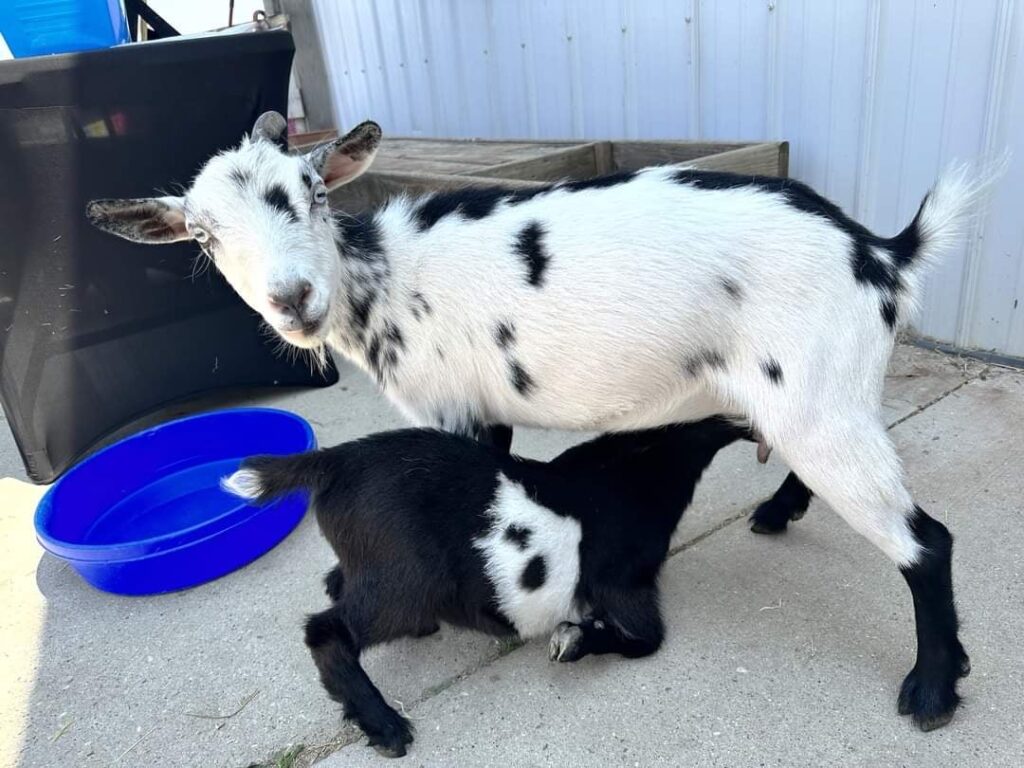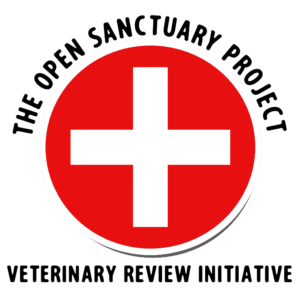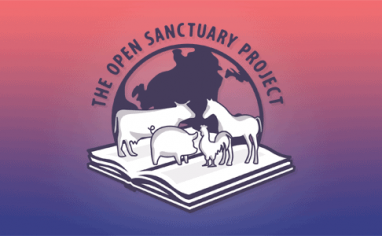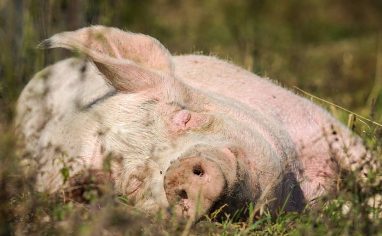

Veterinary Review Initiative
This resource has been reviewed for accuracy and clarity by a qualified Doctor of Veterinary Medicine with farmed animalA species or specific breed of animal that is raised by humans for the use of their bodies or what comes from their bodies. sanctuary experience as of September 2024.
Check out more information on our Veterinary Review Initiative here!
Whether you rescue a sheep or goat who is currently lactating or you rescue a pregnant individual who will eventually need to nurse her babies, it’s important to understand the needs of lactating small ruminants. Failing to meet a lactating sheep or goat’s needs can result in complications both for her and her baby.
Caring For Lactating Individuals Who Are Not Nursing Babies
Just like humans, female sheep and goats produce milk to feed their babies. Unfortunately, given the way they are exploited in agricultural settings, there may be times when you rescue a sheep or goat who is lactating but has been separated from her babies. There may also be times when her baby/babies have tragically died. Caring for a lactating individual who does not have babies with her is different from caring for someone who needs to continue to produce milk to feed her babies. Instead of supporting milk production, you actually want these individuals to stop producing milk (this is often referred to as “drying off”) and, therefore, the diet recommendations in this resource will not be appropriate. We recommend working with your veterinarian to determine the most appropriate diet for her and to watch her closely for signs of mastitis (described below) as she goes through the process of ceasing milk production. In most cases, the standard grass forage-based diet that you feed to your sheep and goat residents who are not pregnant or lactating will be appropriate, but your veterinarian will be able to offer specific guidance.
Proper Nutrition For Lactating Sheep And Goats
Milk production brings about a significant metabolic change for the individual – early lactation (the first 6 weeks after parturition) is the period when a sheep and goat’s nutrition requirements are highest. Therefore, proper nutrition is imperative to ensure she can produce enough milk for her babies without falling into a negative energy balance or dealing with other deficiencies. The specific nutritional needs of a lactating individual will depend on various factors such as their species, age, weight, and the number of babies they are feeding. A mother who is feeding twins will produce approximately 30% more milk than one who is feeding a single baby and will, therefore, require even more nutrition. Please defer to your veterinarian for specific feeding guidance, but below we’ll talk generally about feeding lactating sheep and goats. Typically, a lactating sheep or goat’s diet will continue to consist of concentrates, forages, and free-choice minerals, but with some important changes from what she was fed before giving birth.
As in late pregnancy, energy is the nutrient most likely to be deficient during early lactation, and feeding an appropriate concentrate will help meet her energy needs. In most cases, she will need a larger amount of concentrates than she did during late pregnancy. While the exact amount she requires will depend on the factors listed above as well as the type and quality of the forages she has access to, a more general recommendation is to start by feeding one pound of concentrates per baby she is nursing. Sudden changes in diet can disrupt the delicate balance of rumen microbes, so you should increase the amount of concentrates she is fed slowly over time to avoid complications. Be sure to monitor her body condition for signs she requires more food, making adjustments as needed and in consultation with your veterinarian. While some weight loss is normal during early lactation, significant weight loss is a sign of concern, and could be an indication that she is not receiving adequate nutrition (it could also be a sign of disease, so be sure to consult with your veterinarian).
Because her calcium and protein requirements will be higher than in late gestation, your veterinarian may recommend feeding a good-quality alfalfa hay rather than a grass or mixed grass/legume hay. As we mentioned in Part One of this series, it’s important to have your forages tested so your veterinarian can assess what nutrients may need to be supplemented. Depending on the type and quality of your forages, they may recommend supplementing with additional protein or calcium.
While unrestricted access to fresh, clean drinking water is important for all residents, this is crucial for individuals who are lactating. If you do not have water units that refill automatically, keep a close eye on water levels and be prepared to refill water vessels more often – lactating sheep and goats will drink significantly more water than they did in late pregnancy!
Adjust Their Diet As Milk Production Wanes
As mentioned above, the first 6 weeks of lactation are when the individual’s nutritional needs will be highest. As time goes on, they will produce less milk and will therefore require less nutrition. Failing to adjust their diet as this process happens will result in unhealthy weight gain. While your veterinarian can give you more specific guidance, you can generally start reducing the amount of concentrates they are fed approximately 60 days after they give birth. Barring a health issue that requires forced weaning, sanctuaries typically allow babies to nurse for as long as they want and their mother allows. As the baby is weaned the mother’s nutritional needs will continue to decrease, and once her babies are fully weaned, she should be able to be fed the standard grass forage-based diet your other sheep and goat residents receive.
Healthcare For Lactating Sheep And Goats
There are certain health conditions that most commonly affect lactating sheep and goats, some of which we have already talked about in this series. It’s important to familiarize yourself with these conditions and their signs so you can catch issues early.
Parturient Paresis
As mentioned in Part One of this series, parturient paresis (also known as milk fever or hypocalcemia) most often affects sheep and goats during late pregnancy. However, it can also develop during lactation, most often affecting breeds typically exploited for their milk production (“dairy breeds”). When this condition develops in a lactating sheep or goat, it usually happens 1-3 weeks after giving birth. Be sure to watch for signs of this condition and contact your veterinarian immediately if seen.
Gastrointestinal Parasitism
Remember that sheep and goats experience a temporary reduction in immunity to gastrointestinal parasites (e.g., barber pole worms and coccidia) during late pregnancy that lasts until approximately six weeks after parturition. Be sure to continue using parasite screening strategies and work with your veterinarian to treat anyone who needs it.
Mastitis
Mastitis (inflammation of the udder) occurs more often in lactating sheep and goats who are being manually milked (by hand or with a milking machine), but it can also affect mothers who are nursing their young. Individuals with clinical mastitis will often have a hot, swollen, and painful udder and will not allow their babies to nurse due to associated pain. Other signs of clinical mastitis include fever, inappetence, and depression. In cases of severe mastitis, the udder may become bluish due to issues with blood supply – this is often referred to as “blue bag.”
Sheep and goats can also develop subclinical mastitis, which is more difficult to detect. In this situation, the individual usually appears healthy, but their udder may have firm masses in it, and they will experience a reduction in milk production. If you notice that her babies appear constantly hungry or are losing weight, be sure to check their mother’s udder – she may not be producing enough milk to sustain them.
Be sure to contact your veterinarian if a resident is showing signs of mastitis. They can perform diagnostics to determine the cause and most appropriate treatment option, which typically consists of injectable or intramammary antibiotics and pain medication. In severe cases, a mastectomy may be advised. To ensure her babies continue to receive all the nutrients they need, you may have to start bottle feeding them.
We hope this series has given you a better understanding of the care small ruminants need during pregnancy, labor and delivery, and lactation. Learning about their needs during these stages of their life is an important part of making sure you are prepared to meet those needs, but be sure to consult with your veterinarian for more specific guidance and, as always, please contact them if you have any concerns!
SOURCES:
Feeding Ewes | Sheep 201 (Non-Compassionate Source)
The Periparturient Egg Rise | American Consortium For Small Ruminant Parasite Control (Non-Compassionate Source)
Sheep And Goat Medicine, Second Edition | D.G. Pugh And A.N. Baird (Non-Compassionate Source)
Non-Compassionate Source?
If a source includes the (Non-Compassionate Source) tag, it means that we do not endorse that particular source’s views about animals, even if some of their insights are valuable from a care perspective. See a more detailed explanation here.








